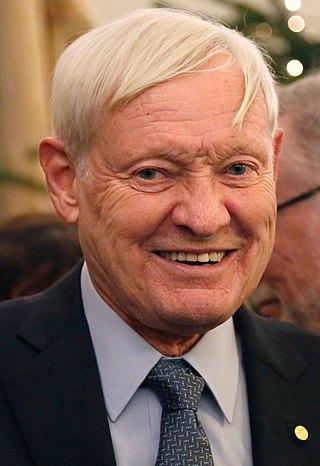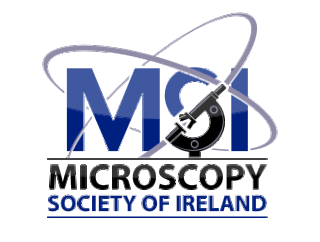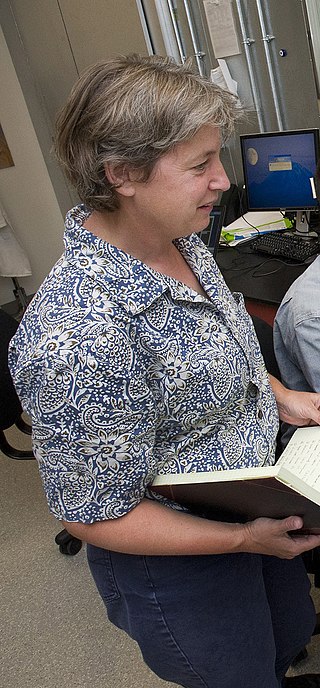Related Research Articles

Richard Henderson is a British molecular biologist and biophysicist and pioneer in the field of electron microscopy of biological molecules. Henderson shared the Nobel Prize in Chemistry in 2017 with Jacques Dubochet and Joachim Frank. "Thanks to his work, we can look at individual atoms of living nature, thanks to cryo-electron microscopes we can see details without destroying samples, and for this he won the Nobel Prize in Chemistry."

Stefan Walter Hell is a Romanian-German physicist and one of the directors of the Max Planck Institute for Multidisciplinary Sciences in Göttingen, and of the Max Planck Institute for Medical Research in Heidelberg, both of which are in Germany. He received the Nobel Prize in Chemistry in 2014 "for the development of super-resolved fluorescence microscopy", together with Eric Betzig and William Moerner.

The Royal Microscopical Society (RMS) is a learned society for the promotion of microscopy. It was founded in 1839 as the Microscopical Society of London making it the oldest organisation of its kind in the world. In 1866, the society gained its royal charter and took its current name. Founded as a society of amateurs, its membership consists of individuals of all skill levels in numerous related fields from throughout the world. Every year since 1841, the society has published its own scientific journal, the Journal of Microscopy, which contains peer-reviewed papers and book reviews. The society is a registered charity that is dedicated to advancing science, developing careers and supporting wider understanding of science and microscopy through its Outreach activities.

Dame Athene Margaret Donald is a British physicist. She is Professor Emerita of Experimental Physics at the University of Cambridge, and Master of Churchill College, Cambridge.

Sir Colin John Humphreys, is a British physicist and Christian apologist. He is the Professor of Materials Science at Queen Mary University of London.

Ondrej L. Krivanek is a Czech/British physicist resident in the United States, and a leading developer of electron-optical instrumentation. He won the Kavli Prize for Nanoscience in 2020 for his substantial innovations in atomic resolution electron microscopy.
Maximilian Haider is an Austrian physicist.

Dame Pratibha Laxman Gai-Boyes is a British microscopist and Professor and Chair of Electron Microscopy and former Director at The York JEOL Nanocentre, Departments of Chemistry and Physics, University of York. She created the atomic-resolution environmental transmission electron microscope (ETEM) and is an outspoken advocate for women with careers in science.
The German Society for Electron Microscopy is a learned society founded in 1949 in Düsseldorf, Germany. Ernst Brüche suggested that an association dedicated to electron microscopy be formed to coordinate German work. In the immediate post-World War II period, there were three German centers of research on electron microscopes: in Berlin under Ernst Ruska, in Mosbach under Brüche, and in Düsseldorf under Bodo von Borries.
The Institute for Functional Imaging of Materials (IFIM) is an organization set up in 2014, within the Oak Ridge National Laboratory (ORNL) situated in Oak Ridge, Tennessee, USA. The goal of the institute is to provide a bridge between modeling and applied mathematics and imaging data collected from various forms of microscopy available at ORNL. The current director of the IFIM is Sergei Kalinin who was awarded the Medal for Scanning Probe Microscopy by the Royal Microscopical Society. The institute supports President Obama's Materials Genome Initiative.

Joachim Frank ; born September 12, 1940) is a German-American biophysicist at Columbia University and a Nobel laureate. He is regarded as the founder of single-particle cryo-electron microscopy (cryo-EM), for which he shared the Nobel Prize in Chemistry in 2017 with Jacques Dubochet and Richard Henderson. He also made significant contributions to structure and function of the ribosome from bacteria and eukaryotes.

The Microscopical Society of Ireland (MSI) is a learned society for the promotion of microscopy in Ireland. It was founded in 1975 as the Irish Society For Electron Microscopy and held its first symposium the following year at University College Dublin, an event they have held every year since 1979. It shares the Journal of Microscopy with the Royal Microscopical Society as its official journal. The society is the member organisation of the European Microscopy Society representing the island of Ireland.
The International Federation of Societies for Microscopy is an international non-governmental organization representing microscopy. It currently has 37 national members and 9 associate members, which are split into three regional committees, the Committee for Asia-Pacific Societies of Microscopy, the European Microscopy Society and the Interamerica Committee for Societies for EM.
The Nordic Microscopy Society (SCANDEM) is a learned society for the promotion of microscopy in the Nordic countries. It was founded on 16 October 1948 at the Research Institute of Experimental Physics in Stockholm, Sweden and was originally called the Scandinavian Society for Electron Microscopy (SCANDEM), reflecting the region of Europe the founding members of Denmark, Norway and Sweden are located. This name was in use until 2002 when it was changed to its current name to reflect the shift towards encompassing the broader field of microscopy. The society is a member of the European Microscopy Society committee of the International Federation of Societies for Microscopy.
The Swiss Society for Optics and Microscopy (SSOM) (French: Société Suisse d'Optique et de Microscopie Électronique (SSOME); German: Schweizerische Gesellschaft für Optik und Elektronmikroskopie (SGOEM)) is a learned society for the promotion of optics and microscopy (and more recently nanotechnology) in Switzerland.
Peter Duncumb is a British physicist specialising in X-ray microscopy and microanalysis. He is best known for his contribution to the development of the first electron microprobe.

Frances Mary Ross is the Ellen Swallow Richards Professor in Materials Science and Engineering at Massachusetts Institute of Technology. Her work involves the use of in situ transmission electron microscopy to study nanostructure formation. In 2018 she was awarded the International Federation of Societies for Microscopy Hatsujiro Hashimoto Medal. Ross is a Fellow of the American Association for the Advancement of Science, the American Physical Society, the Microscopy Society of America and the Royal Microscopical Society,
Caterina Ducati is a Professor of Nanomaterials in the Department of Materials at the University of Cambridge. She serves as Director of the University of Cambridge Master's programme in Micro- and Nanotechnology Enterprise as well as leading teaching in the Nanotechnology Doctoral Training Centre.
Peter David Nellist, is a British physicist and materials scientist, currently a professor in the Department of Materials at the University of Oxford. He is noted for pioneering new techniques in high-resolution electron microscopy.
Amalia Patanè is an Italian physicist who is Professor of Physics at the University of Nottingham and UK Director of the European Magnetic Field Laboratory.
References
- 1 2 "History". www.eurmicsoc.org. Retrieved 15 May 2017.
- 1 2 3 4 "European Microscopy Society - Yearbook 2016". www.eurmicsoc.org. 2016. Bresson, Isère: Manufacture d'Histoires Deux-Ponts: 3, 8–9, 52–53. 15 February 2017. ISSN 1609-1191 . Retrieved 17 June 2017.
- ↑ "2016-2020 Board". www.eurmicsoc.org. Retrieved 15 May 2017.
- 1 2 "European Microscopy Society - Yearbook Profile". Union of International Associations . Archived from the original on 2 April 2019. Retrieved 15 May 2017.
- ↑ "National and regional societies". www.eurmicsoc.org. Retrieved 15 May 2017.
- ↑ Physics, Institute of. "Electron Microscopy and Analysis Group". Institute of Physics . Retrieved 16 May 2017.
- ↑ Paavolainen, Lassi. "About the Society". Nordic Microscopy Society . Retrieved 15 May 2017.
- ↑ "Membership Benefits". Royal Microscopical Society . Retrieved 15 May 2017.
- ↑